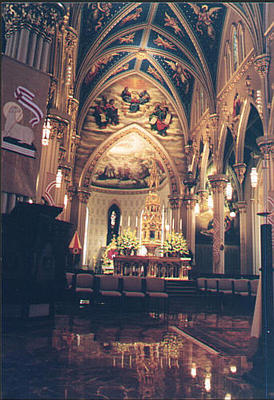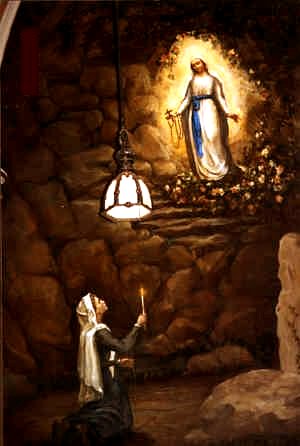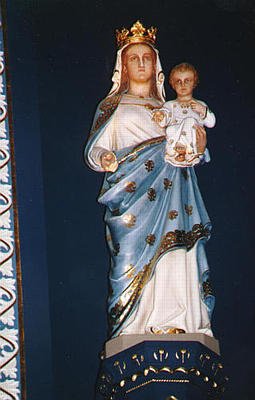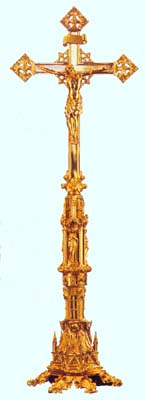
Notre Dame's Grotto / by Dorothy V. Corson


The Completion of the Sacred Heart Lady Chapel
It took fourteen years after Father Lemonnier's death in 1874, to finish the church and the remaining chapels. During that time the original plans to dedicate the large chapel in Father Lemonnier's memory were modified. Father Sorin built his Grotto of Our Lady of Lourdes in 1878. Subsequently, an altar below the painting of the Lourdes Grotto, and a stained glass window depicting The Immaculate Conception,(102) were added to the church. The newly completed larger chapel, graced with its Madonna statue, became the Lady Chapel instead.
 The next event of importance concerning the Blessed Virgin, the new church and Lourdes, was the completion of Gregori's painting of the Our Lady of Lourdes Grotto in the church. A detailed description of the large painting was printed in the Scholastic on September 8, 1888.
The next event of importance concerning the Blessed Virgin, the new church and Lourdes, was the completion of Gregori's painting of the Our Lady of Lourdes Grotto in the church. A detailed description of the large painting was printed in the Scholastic on September 8, 1888.
Probably the largest representation of the apparition of Our Lady of Lourdes that exists anywhere was lately finished by Signor Gregori in a Gothic angle of the church of the Sacred Heart at Notre Dame over an altar dedicated to the Immaculate Conception. It represents the fifth apparition. The Blessed Virgin stands over a cleft of the rock; the Rosary is suspended on her wrist, and she is about to make the Sign of the Cross. Bernadette kneels at her feet, gazing upward and holding a lighted taper. The stream in the foreground, the rocks and foliage are skillfully painted, and so true to nature as to deceive those entering the church at the main door. The painting is 12 feet wide below and twice as high.(103)
The Lourdes altar under the Grotto painting was later removed during one of the renovations.
Over the years, many articles written about the church identified the crown on the Madonna statue in the new Lady Chapel as the Empress Eugenie crown. It had already been missing from the church for some time.
During the month of April, 1889, eight months after the Grotto painting was completed, three brief entries described the arrival of the Madonna statue destined for the Lady Chapel. They were small, but they were evidential in proving the crown on the statue was definitely not the Eugenie Crown.
On April 6, 1889, this interesting entry appeared:
A new and artistic statue of the Madonna and child has been placed in a niche in the small tower back of the Minim's chapel in the church. Very beautiful effects are produced by the variegated colors of the windows surrounding the statue.(104)
No one among the elderly priests on campus had ever heard of the "Minim's Chapel." The chapel described above had always been referred to in the church as the Holy Angels Chapel, or more recently, the Laetare Chapel. In an 1878 Scholastic entry,(105) was the confirmation: "Sodality of Holy Angels , 1st organized 1857 by Gillespie in 1875, was changed from Junior to Minims Dept ."
 On April 20, 1889, another entry appeared: "The Senior Archconfraternity have purchased a handsome statue of the Blessed Virgin which will be placed in the church during the month of May when the students attend May devotions."(106)
On April 20, 1889, another entry appeared: "The Senior Archconfraternity have purchased a handsome statue of the Blessed Virgin which will be placed in the church during the month of May when the students attend May devotions."(106)
On June 2, 1889, yet another, confirming mention: "The new pedestal for the statue, which members of the Archconfraternity recently received from France, is a real work of art."(107)
These three brief entries in the pages of the Scholastic verified the origin of the present Madonna statue. It was a gift of the Senior Archconfraternity, was made in France, was placed in its niche in 1889, and is still there today 104 years later.
This information put to rest false statements made in early written sources, that referred to the Crown on the statue in the Lady Chapel as the 1866 Empress Eugenie Crown. The crown on the Madonna is embossed gold. There are no jewels in it, which alone would prove it is in no way connected with the missing Empress Eugenie Crown.
During the last renovation of the church, completed in 1992, the Madonna statue was removed from the niche and repainted. Those who saw it up close have confirmed it. The crown was not separate, it was part of the statue. When it was repainted during the renovation the crown and other gold areas on the statue were newly gold leafed.
When the statue was removed from its niche to be refurbished several three dimensional heart-shaped gold boxes made of brass, containing prayers and petitions, were found under the pedestal. The oldest among them had seven petitions. One petition, signed by Father Sorin and dated 1876, was a heart made of paper like a small valentine with a picture of the founder. A second one, dated 1878, was from a Sister, signed M.P.B., asking for a happy death. Another, dated 1885, included prayers for someone's mother.
Duly noted, they were returned to the niche with the renovated statue, along with several new petitions; there to reside for perhaps another one hundred years. With the disparity in the dates, speculation naturally followed. Where were they before they were moved there in 1889? Could they have once been in the octagonal tower niche of Father Sorin's original 1878 Grotto?
Petitions were also found in hymnals, and under the carpeting of the church near the altar when it was removed during renovation. A slip of paper with what was thought to be the names of early craftsmen who had worked on the church, was also found. This is not an uncommon practice among tradesmen. Even today, masons have been known to write their names on a piece of paper and drop it, like a time capsule, into the opening of a cement block or behind a brick.
It is practically certain that at the time of the robbery in 1886 the Eugenie crown was safe. It was hidden away after the robbery to be returned later. Probably no one at the time suspected that it would take almost another three years before the chapel interiors were completed. Perhaps, when the time came to replace it, no one remembered where the crown had been hidden or what had happened to it. The statue it was on had been removed from the church three years before, so there was no reason to look for it. Thus, a new Madonna statue was ordered for the new Lady Chapel.
Since the Empress Eugenie crown has never been found, and there is no other crown like it anywhere in the church or on the campus, regrettably, "The Forgotten Crown" story seems to be the only plausible explanation for its disappearance. It has been thoroughly researched and nothing has been found to contradict it being a true story.
A similar little known incident, filed away in the same Sacred Heart Church folder in the University Archives, adds further credence to the story. This incident was reported in an article published in the 1933 South Bend News Times :

A six-foot hand-wrought bronze crucifix, the gift of Napoleon III of France to the University of Notre Dame was "discovered" Saturday by workmen preparing scaffolding for the renovation of the Gregori frescoes in Sacred Heart church.
Someone in the dim past, evidently confronted with the need for an altar crucifix for the apsidal chapel, entered upon the west side of the adoration chapel, and placed the crucifix behind the altar. There it stood, no one knows how many years, with only the plain top of the cross showing above the back of the altar. The exquisite design of the carved base could not be seen. No one remembers when the cross was first "missed." It's "disappearance" is paradoxical in that hundreds of people saw it during the years it was lost.(108)
The last line of the above newspaper story could have been written about the Empress Eugenie crown. Its disappearance was also paradoxical. Many people also saw it and handled it during the years it was lost. Fortunately, in the case of Napoleon's crucifix, it was more happily concluded. It is now displayed in the Laetare Chapel in the Basilica of the Sacred Heart.